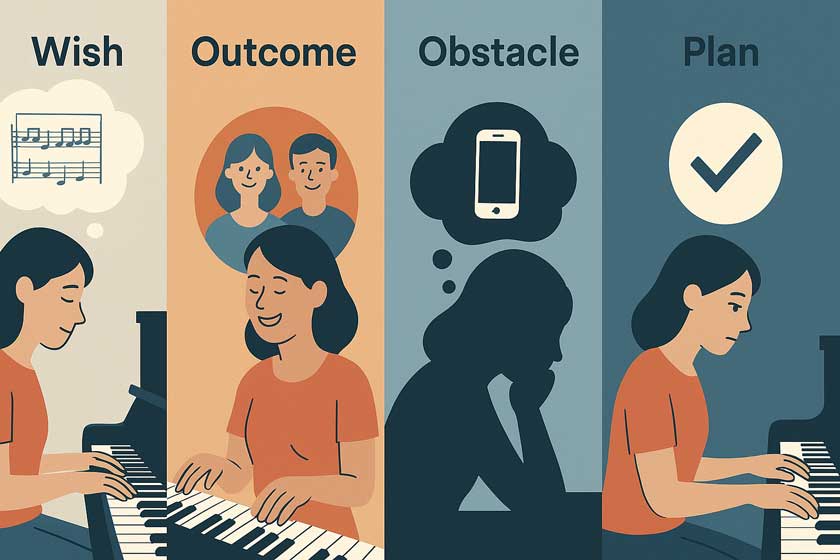Have you ever made a wish or visualized your ideal outcome, only to feel stuck before taking real action? You’re not alone. While dreaming is a powerful start, real progress happens when you pair those dreams with a sharp look at what’s standing in your way — and a plan to get through it. This post introduces a science-backed method used in psychology and behavioral coaching that makes your goals dramatically more achievable, especially for piano learners and adult students. It’s called WOOP, and it may be just what your practice routine has been missing.
Ever feel like you want to improve at piano but just… don’t?
You dream of playing fluently, but somehow your fingers, your time, or your energy don’t quite cooperate?
You’re not alone. But the good news is: there’s a tool that can help.
It’s called mental contrasting, and it’s the science-backed foundation behind the WOOP method by psychologist Gabriele Oettingen. And yes, it works beautifully for piano practice.
Let’s break it down and walk through the exercise – step by step – for your music journey.
Step 1: W is for Wish – What Do You Really Want?
Start by choosing a piano-related goal or habit you’d like to develop.
Keep it realistic but meaningful – something challenging enough to spark motivation, yet achievable within a clear time frame.
Here are a few examples:
“I want to practice piano 15 minutes every day for the next month.”
“I want to master the first part of the Moonlight Sonata in three weeks.”
“I want to feel confident using different rythms to accompany songs I like by the end of the year.”
Choose only one wish at a time. Visualize it clearly. Say it aloud. Write it down.
Step 2: O is for Outcome – What Would That Feel Like?
Now imagine what your life (and music) would be like if that wish came true.
What’s the best thing that would happen if you actually achieved it?
Close your eyes if that helps. Picture:
- You sitting at the piano and playing with flow and confidence.
- The smile on your face as muscle memory kicks in.
- Friends or family listening, impressed and proud.
- That deep feeling of satisfaction in your chest.
Most importantly: how would it feel in your body?
Relaxed shoulders? Excitement? Calm focus?
Let yourself live in that moment — the “future you” who did it.
Step 3: O is for Obstacle – What’s Actually in the Way?
Here’s the hard part: honesty.
If that future is so amazing… why hasn’t it happened yet?
It’s tempting to blame lack of time, distractions, or bad luck — but WOOP asks us to look inside. Your inner obstacle might be:
- A recurring thought: “I’m too old to learn an instrument.”
- An emotion: “I feel overwhelmed whenever I sit at the piano.”
- A habit: “I reach for my phone instead of starting practice.”
- A belief: “If I can’t play it perfectly, I might as well not try.”
This step requires courage. We’re so used to rationalizing or staying on the surface. But your breakthrough lives beneath those reflexes.
So pause. Dig a little deeper. What internal blocker is tripping you up?
Once you find it, imagine it clearly: how it shows up, how it feels, how it derails you.
Step 4: P is for Plan – What Will You Do When It Strikes Again?
Now comes your secret weapon: the If–Then Plan.
Think about the next time that internal obstacle is likely to show up.
Let’s say your obstacle is: “I get distracted by YouTube when I’m supposed to practice.”
Your plan could be:
If I catch myself opening YouTube before piano practice,
Then I’ll close the tab, set a 10-minute timer, and sit at the piano for just one piece.
This tiny plan is powerful. It’s not just motivational fluff — it rewires your response.
It creates a shortcut in your brain: when X happens, I do Y.
Write it down like this:
Wish: Practice 15 minutes daily
Outcome: I feel proud, relaxed, and energized after playing
Obstacle: I procrastinate by scrolling on my phone
Plan: If I reach for my phone at practice time, then I’ll put it in another room and start with a song I like at the piano
I can tell you that right now my plan goes like this: “If I haven’t yet practiced in the morning, then I’ll take 15 minutes right before lunch while food is warming up to go through what I was practicing yesterday”
Let’s put it together just for you
Here’s something you can print and fill in if you find it useful.

This isn’t about guilt or pushing yourself harder.
WOOP works because it activates non-conscious processes — your mind starts rehearsing better responses before the problem even hits.
In fact, studies show that people who use mental contrasting and WOOP are significantly more likely to achieve their goals than those who just visualize success. To be more exact, they are 2 to 3 times more likely to achieve goals! This means an increase of 100% to 200% in success rates compared to participants who used positive visualization alone or no strategy.
It builds automatic motivation. And with piano, where progress often feels slow or invisible, this inner alignment is gold.
Repeat It, Refresh It
Use WOOP anytime you feel stuck or frustrated. One goal at a time. Rinse and repeat.
Whether you want to sight-read better, stop skipping practice, or finally memorize a Gnossienne — this tool puts the control back in your hands (and fingertips).
Final Note: You’re Not Behind — You’re Becoming
WOOP isn’t magic — but it does make your goals feel real and doable, even on hard days.
So next time you’re tempted to give up or scroll away, try this:
“A WOOP a day keeps the piano blues away.”



